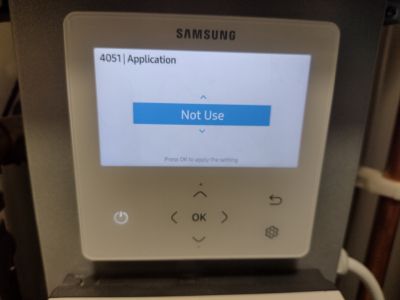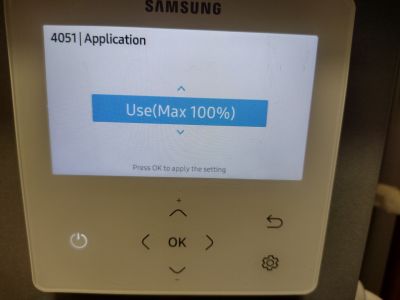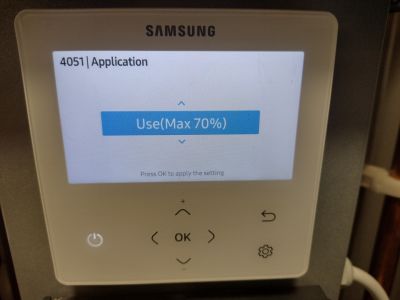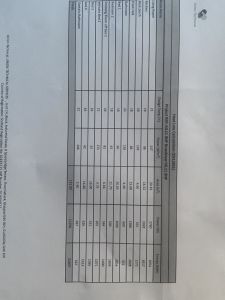Is this a bad installation and is there something wrong with my Samsung heat pump?
Posted by: @derek-mThe parameter FSV #4051 should contain the value 0, 1 or 2, so you are probably looking at the displayed result rather than the actual set value. To change any of the set values you will probably need to be in 'Installer Mode' or Samsungs equivalent.
This has always confused me. The only way to change the FSV parameters I have found on my Gen 6 Wired Remote Controller is the Installation/Service Mode (entered with the 3 second simultaneous up/down arrow press then password entry). In this mode the FSV parameter values are selected by scrolling through the options that are displayed as text descriptions, such as "Use(Max 100%)" for the 4051 setting as seen here:
Unfortunately, the FSV descriptions in the User Manual use the numeric values (0, 1, 2 as you specify) so it is a case of trying to map from the required number to the text description in the Wired Remote Controller user interface. This is not too difficult for some parameters but for others the mapping to UI description is not very obvious.
It would be so much simpler to select the numeric value. Perhaps there is some configuration option that switches to numeric rather than text selection 🤔
Posted by: @sjnIt would be so much simpler to select the numeric value. Perhaps there is some configuration option that switches to numeric rather than text selection
It probably wouldn't be too difficult to add the FSV number at top-right of the display as an interim 'solution'.
That would prevent confusion as to which parameter was being addressed by the text description.
Why not send this to Samsung as feedback?
Save energy... recycle electrons!
@transparent heating guys gone, running at 37lpm. I chose to remove the gauze filter from the inline filter outside it was very restrictive and fingers crossed it runs well now. The antifreeze never made much difference in the flow rate if any but time will tell. 🤞
Glycol has a lower thermal capacity than water.
To transfer the same amount of energy (joules), the pump will have to send more fluid around the pipes.
I don't know enough about the logic/software within the Samsung controller to suggest how it will respond to that requirement.
Glycol is also more likely to leak from fittings which haven't been made tight enough.
That's tricky to see if your pipework has been properly insulated of course!
Save energy... recycle electrons!
@transparent here is one for you transparent. Do you run your batteries down to zero. I charge mine to 100% , but discharge to 25%. I usually dump it back to grid 4-5pm.
Posted by: @derek-m'Inverter pump use' - means that the speed of the water pump is varied by the controller.
This only happens if a PWM pump is fitted with the appropriate wiring - very unlikely in this case. So adjusting these settings makes no difference to anything.
Posted by: @david999I chose to remove the gauze filter from the inline filter outside it was very restrictive and fingers crossed it runs well now.
I am not an engineer, just a Samsung ASHP owner, but everything that I have read suggests that removing the filter is a bad idea. There are two reports on this forum of low flow problems associated with the strainer filter being omitted from the install. This was despite the manual stating that the strainer is mandatory. In one case this required an expensive system flush. When my system was upgraded to open loop, Brendon Uys recommended removing the magnetic filter as many such filters restrict flow and then putting a magnet on the strainer filter.
@mike-h I have seen such filters on other applications and found them problematic, the magnetic filter and cage is fitted in the return where it should catch anything ugly before it gets to the heat pump. The original filter had been in a short time and it shared some of the sludge and debris the mag filter had snagged, however when I removed it it was clear that the flow rate was compromised and that a new basket rather than a clean would be best. I can’t see any reason why removing the basket would restrict flow, it’s an obstruction whether it’s clean or not. I also removed the manual flow guage as well since it was a restriction and I may swap out the Honeywell 3 port for a better full bore type later since the 28mm valve seems to have a small bore inside, 22mm I think. I had the engineers remove most of the 90 degree couplings and opted to attacking the pipe with a bender. The 90s are restrictive. I made sure all valves were full bore, the flow meter sited as specified and it’s all running well at the minute. 🤞
Posted by: @david999here is one for you transparent. Do you run your batteries down to zero. I charge mine to 100% , but discharge to 25%. I usually dump it back to grid 4-5pm.
Can you ask this question in a battery-storage related topic please @david999 ?
This one on Beginners DIY Battery storage with no solar would do fine.
If I answer it here
- it will take us off-topic because others in this thread will want to pass comment on what I suggest
- new members arriving on the forum in future won't think to look here for such an answer
The concept of running batteries down to zero has become enshrined in the new PAS63100 BSI Standard.
So it's increasingly important that we air our views on what that means.
This discussion about storage batteries can now be followed here.
Save energy... recycle electrons!
@transparent hi guys, just an update on where I am at the minute and a couple of questions please.
samsung eventually stepped in to help out and my installer is working on resolving my heating issues and refunding my own engineers fee. It’s been a difficult time and at that point where the installer had lost patience with me and basically telling me the case was closed. Too much work out there for them and not enough training or time given to provide a service and it all needs to stop now before hundreds of homes are ruined.
may I ask a couple of questions please. I have attached the heat loss calculations for my home, how do I use them to work out what size of heat pump I need. In collaboration with samsung my installer has determined, they say,
that my 16 kw pump can work to these heat loss figures if the flow is reduced from 46lpm to 36lpm and retaining the 28mm pipework increasing the pump sizes to 100 watt and 75watt. What do you think since I won’t know until winter if it’s ok.
the other question is that I would like to reduce the flow temperature to perhaps 22c since 19-21 has been comfortable in our home. Would that work? And if so would that impact on the cost of DHW since the immersion would have to heat it from 22c -55. I want the legionella cycle turned off since we use a fair bit of water and at 55c it should be fairly safe anyway.
the installer is out tomorrow to complete the repairs listed and program the system to match the heat loss figures but I have zero confidence in them and could you help out with any guidance on numbers I am looking at.
If you're contemplating changing any pumps, please first re-read what @mike-h posted further up this page.
This might be the opportunity to change to a pump which does have external controls for modulation/pressure/flow or whatever other features your Samsung controller might be able to use.
Save energy... recycle electrons!
- @transparent it’s the pump samsung recommend with a facility to connect to the pcb so it can modulate.
- we all make mistakes but this install was a train wreck. Installed in November and signed off as commissioned to samsung to facilitate a 7 year warranty, but found out when my engineer inspected and reported. All they had to do was rectify the install according to the data I got from Samsung, but their reluctance to change the pipework to 35mm meant they then asked samsung for a way around it and admitted they screwed it all up. I hadn’t mentioned my installer so when they introduced themselves as my installer all the shoddy workmanship I had been detailing over the months suddenly got a handle.
- now does samsung continue along this path allowing them to install their product on the back of being trained to samsung standards and accredited to sign off extended 7 year warranties. Would you?
- 26 Forums
- 2,396 Topics
- 54.3 K Posts
- 403 Online
- 6,077 Members
Join Us!
Worth Watching
Latest Posts
-
RE: Setback savings - fact or fiction?
The costs, if any, are not that great - see my calculat...
By JamesPa , 1 hour ago
-

RE: Weather compensation- why you should use it
I think we're starting to veer off topic again (probabl...
By Majordennisbloodnok , 1 hour ago
-
RE: Recommended home battery inverters + regulatory matters - help requested
Only the manual The commissioning documents state which...
By JamesPa , 2 hours ago
-

RE: Electricity price predictions
As electricity prices continue to rise and specialist h...
By Mars , 2 hours ago
-
RE: New Mitsubishi Ecodan 11.2kW installation - L9 errors and maybe more
Your installer is probably right. The L9 error means l...
By JamesPa , 3 hours ago
-

RE: New Fogstar 15.5kWh upright solution
Thank you. No-one did. You posted some links to ...
By Majordennisbloodnok , 3 hours ago
-
Just realised that this image of the cylinder cupboard ...
By Sheriff Fatman , 3 hours ago
-

RE: Rodents! A word of warning for heat pump owners
Two thoughts: 1: Let's ask @david-s if Primary Pro in...
By Transparent , 3 hours ago
-
RE: Solis S6-EH1P8K-L-PLUS – Why I Chose It and What I’ve Learned So Far
In the diagram below, I describe my understanding of th...
By Batpred , 4 hours ago
-
RE: Running from backup generaor in powercut?
@batpred Thanks for the warning. definately a job for a...
By Pipcart , 4 hours ago
-
RE: ASHP Energy Consumption: Aira 12kW heat pump
@editor Mars, First of all thank you for your enco...
By Wally , 4 hours ago
-
I need to have a look out for it. I know IBM feeds some...
By Batpred , 5 hours ago
-
-
RE: Daikin Atherma ASHP Cycling 6 Times an Hour?
Thanks for your reply. Yes that's a good idea to try a...
By John Marshall , 10 hours ago
-

RE: Hot water heating in parallel with space heating
An external heat exchanger would need a pump which woul...
By bontwoody , 11 hours ago
-
RE: Gen 6 Samsung ASHP losing 20C of DHW in 60 min directly after generation
@ecobaker Thanks for this. I've had it in both slots. ...
By andbeck , 21 hours ago
-

RE: Air source heat pump circuit not operational
Welcome to the forums. If the thermostat shows it’s c...
By Mars , 21 hours ago
-
RE: Ecodan with FTC7 - True Weather Compensation
@danwright90 I've linked two videos below recorded this...
By Sheriff Fatman , 23 hours ago
-

RE: Advice for a novice on Mitsubishi Ecodan 6kW
That makes plenty of sense. Perhaps more importantly, O...
By Majordennisbloodnok , 1 day ago








